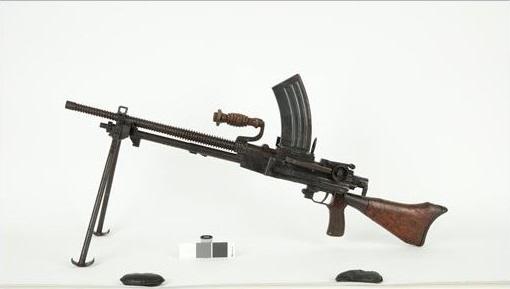Conservation of a Type 96 light machine-gun

Figure 1: Type 96 light machine-gun, Japan, before treatment.
REL28098
his Type 96 is believed to have been captured from Japanese forces at the end of August 1942 near Rabi Mission, on the northern shore of Milne Bay. The light machine-gun has been selected as part of a new display in Anzac Hall.
In preparation for the display, the conservation team carried out a treatment to stabilise the firearm and make it safe for display, including removing radioactive sights from the weapon.
Conservation treatment to clean and stabilise corrosion on the firearm involved dismantling the weapon, which has over 50 components, and cleaning the components using solvents, a heated ultrasonic bath, and an air-powered dental brush. The ultrasonic bath cleans objects by projecting high frequency sound waves through a mixture of water and detergent, forming cavitation bubbles at the surface of the object which penetrate dirt and grime. Corrosion was reduced with an air-abrasive bead blaster, and chemically treated with tannic acid to convert it into a non-corrosive substance. Static metal components were then hot waxed with microcrystalline wax, buffed and reassembled while hot. Moving components were coated with a corrosion inhibiting wax-like film and grease to ensure smooth movement when reassembled. These coatings will protect the metal surface in the unlikely event that it is scratched, handled without gloves, or exposed to water – all of which can cause further corrosion.
The firearm had paint splatters over the stock which may have occurred during past storage. We decided to remove the paint splatters from the timber because they did not contribute to the story of the object, but drew the viewer’s eye and told a different story about the object’s life after Milne Bay. The timber was cleaned using solvents, and the paint splatters were removed with a scalpel.
This extensive treatment ensures that the Type 96 will be safe and stable while it is on display in the galleries.

Figure 2: Type 96 sub-light machine gun (REL28098), Japan, after treatment with a Type 96 magazine (REL28098.004) inserted for display.